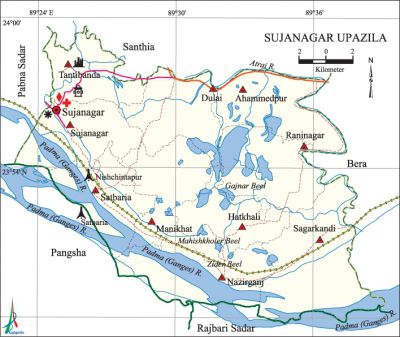Sujanagar Upazila
Sujanagar Upazila (pabna district) area 338.65 sq km, located in between 23°48' and 24°00' north latitudes and in between 89°23' and 89°38' east longitudes. It is bounded by santhia upazila on the north, rajbari sadar and pangsha upazilas on the south, bera upazila on the east, Pangsha and pabna sadar upazilas on the west.
Population Total 278096; male 138559, female 139537; Muslim 268256, Hindu 9813, Christian 15 and others 12.
Water bodies Main rivers: padma, atrai; Gajnar Beel, Mahishkholer Beel and Zider Beel are notable.
Administration Sujanagar Thana was formed in 1872 and it was turned into an upazila in 1983.
| Upazila | ||||||||
| Municipality | Union | Mouza | Village | Population | Density (per sq km) | Literacy rate (%) | ||
| Urban | Rural | Urban | Rural | |||||
| 1 | 10 | 171 | 182 | 25461 | 252635 | 821 | 44.6 | 41.6 |
| Municipality | |||||
| Area (sq km) | Ward | Mahalla | Population | Density (per sq km) | Literacy rate (%) |
| 11.08 | 9 | 24 | 25461 | 2298 | 44.6 |
| Union | ||||||||
| Name of union and GO code | Area (acre) | Population | Literacy rate (%) | |||||
| Male | Female | |||||||
| Ahammedpur 17 | 8688 | 18673 | 19069 | 49.9 | ||||
| Tantibanda 95 | 5690 | 10046 | 10254 | 41.0 | ||||
| Dulai 19 | 7863 | 13264 | 13295 | 46.4 | ||||
| Nazirganj 47 | 11016 | 11518 | 11522 | 41.5 | ||||
| Manikhat 38 | 7566 | 15081 | 15457 | 43.4 | ||||
| Raninagar 57 | 9345 | 9141 | 9274 | 42.8 | ||||
| Sagarkandi 66 | 12424 | 16762 | 17194 | 34.8 | ||||
| Satbaria 76 | 6832 | 12853 | 13057 | 39.2 | ||||
| Sujanagar 85 | 4884 | 9469 | 9150 | 34.6 | ||||
| Hatkhali 28 | 6637 | 8944 | 8612 | 37.5 | ||||
Source Bangladesh Population Census 2011, Bangladesh Bureau of Statistics.

Archaeological heritage and relics Zamindar Bari of Tantibanda, Dulai Chowdhury (Zamindar) Bari, Hemrajpur Shiva Mandir and Durga Mandir.
Historical events During the sepoy revolt in 1857 Zamindar Govinda Chowdhury of village Tatibanda helped the British in resisting the revolt by employing guards on the banks of the Padma and jamuna rivers so that the suspects could not cross the rivers. Governor Lord Mayo was satisfied for the services of the zamindar and he visited Tatibanda village. Peasant rebellion and communal riot were took place in Sujanagar in 1872 and 1926 respectively. On 21 February 1969 Jamadar Abul Hossain was shot dead by the police at the playground of Sujanagar High School.
War of Liberation During the war of liberation direct encounters were held between the freedom fighters and the Pak army in different places of the upazila including at Sagarkandi, Satbaria, Bhabanipur and Nischintapur. On 14 December three freedom fighters were killed in an encounter with the Pak army. Besides, during the War of Liberation freedom fighters Abdul Awal, Abdul Barek and Sadek were killed. Sujanagar was liberated on 15 December. Mass killing sites have been discovered at 3 places (Bhabanipur, Nischintapur and Satbaria) of the upazila.
For details: see সুজানগর উপজেলা, বাংলাদেশ মুক্তিযুদ্ধ জ্ঞানকোষ (Encyclopedia of Bangladesh War of Liberation), বাংলাদেশ এশিয়াটিক সোসাইটি, ঢাকা ২০২০, খণ্ড ১০।
Religious institutions Mosque 304, temple 58, tomb 1. Noted religious institutions: Sujanagar Jami Mosque, Satbaria Jami Mosque, Dulai Chowdhury Bari Jami Mosque, tomb of Hazrat Shah Mahtab Uddin (R) at Sagarkandi, Sideshwari Kali Mandir.
Literacy rate and educational institutions Average literacy 41.9%; male 43.8%, female 40.1%. Educational institutions: college 7, secondary school 33, primary school 136, kindergarten 7, madrasa 6. Noted educational institutions: Satbaria College (1966), Khalilpur High School (1901), Dulai High School (1967), Durgapur Government High School, Raninagar Government High School, Ulat Siddiqia Fazil Madrasa (1915).
Newspapers and periodicals Weekly: Palli Barta.
Cultural organisations Library 25, women's organisation 7, playground 16, stadium 1, cinema hall 1.
Main sources of income Agriculture 61.17%, non-agricultural labourer 2.89%, industry 5.95%, commerce 12.73%, transport and communication 2.71%, service 5.72%, construction 0.95%, religious service 0.17%, rent and remittance 0.41% and others 7.30%.
Ownership of agricultural land Landowner 53.50%, landless 46.50%; agricultural landowner: urban 44.85% and rural 54.59%.
Main crops Paddy, wheat, jute, sugarcane, ground nut, onion, garlic, vegetables.
Extinct or nearly extinct crops Kaun, tobacco, maize.
Main fruits Mango, jackfruit, litchi, papaya.
Fisheries, dairies and poultries Fishery 29, dairy 128, poultry 18, hatchery 22.
Communication facilities Pucca road 260 km, semi-pucca road 10 km, mud road 308 km; waterway 25 km.
Extinct or nearly extinct traditional transport Palanquin, horse carriage, bullock cart.
Noted manufactories Rice mill, flour mill, ice factory, textile mill, welding factory.
Cottage industries Goldsmith, blacksmith, weaving, bamboo work, cane work, wood work.
Hats, bazars and fairs Hats and bazars are 32, fairs 4, most noted of which are 'Sujanagar Bazar, Nischintapur Bazar, Raipur Bazar, Shayampur Hat, Satbaria Hat, Raninagar Hat, Durgapuja Mela at Sujanagar and Joykali Bari Mela.
Main exports Onion, garlic, ground nut, sari, lungi, gamchha.
Access to electricity All the wards and unions of the upazila are under rural electrification net-work. However 58.1% of the dwelling households have access to electricity.
Natural resources Mineral oil has been detected at village Mobarakpur of Ahammedpur union.
Sources of drinking water Tube-well 96.2%, tap 0.6% and others 3.2%.
Sanitation 61.5% of dwelling households of the upazila use sanitary latrines and 33.9% of dwelling households use non-sanitary latrines; 4.6% of households do not have latrine facilities.
Health centres Upazila health complex 1, family planning centre 10, satellite clinic 3, union health and family welfare centre 5, clinic 1, community clinic 26.
NGO activities Operationally important NGOs are brac, asa. [Md. Habibullah]
References Bangladesh Population Census 2001 and 2011, Bangladesh Bureau of Statistics; Cultural survey report of Sujanagar Upazila 2007.
